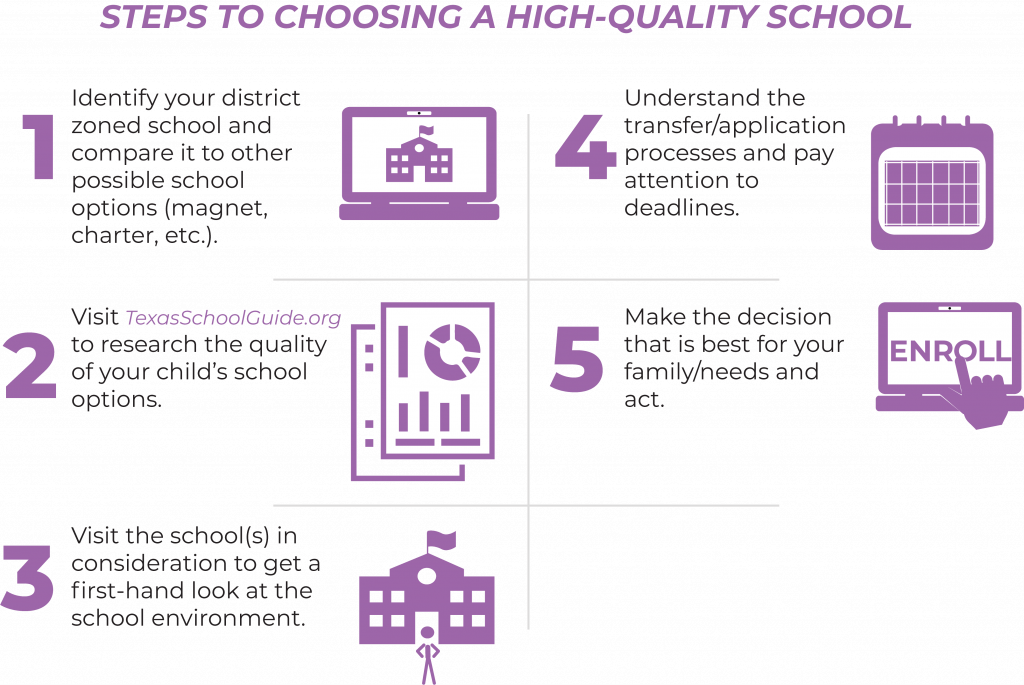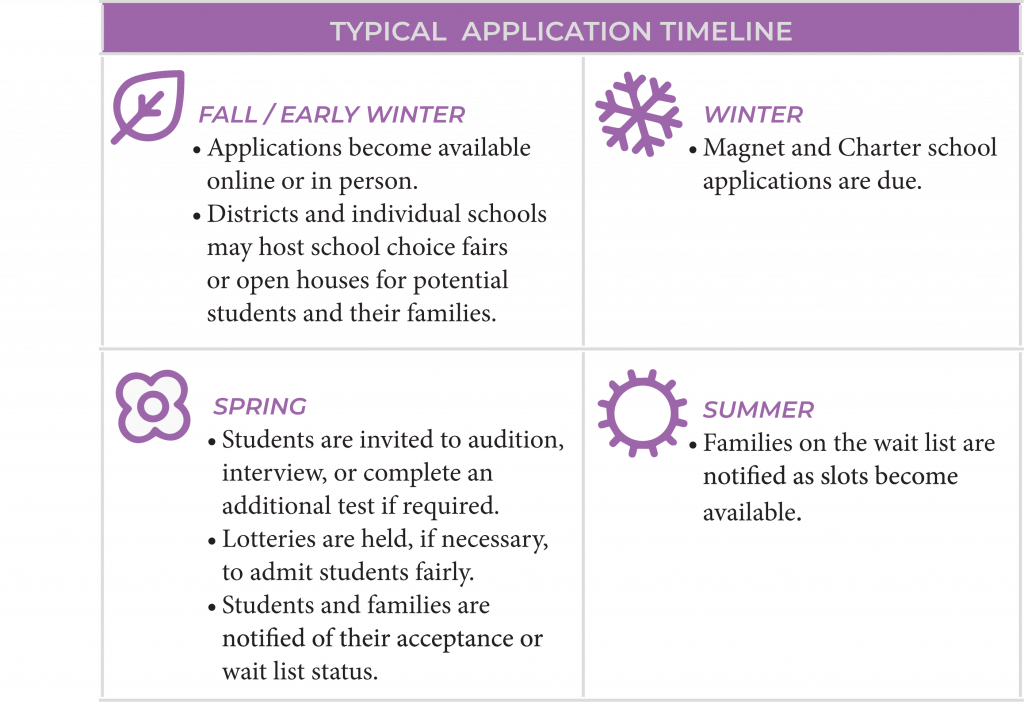TYPES OF SCHOOLS
Most often, students attend the school they are assigned to based off their home address. While many of these District Zoned Schools serve students well, they are not the only option. There are other types of schools children can attend through a transfer or application process.
 A District Zoned School is the neighborhood school that a child is assigned to based on where he/she lives. District Zoned schools:
A District Zoned School is the neighborhood school that a child is assigned to based on where he/she lives. District Zoned schools:
• Are made up of students from a specific neighborhood or zip code
• Are free to attend for all students in their district zone
• Are where a child will attend if they do not apply elsewhere or are unable to transfer
 A Magnet Program or School is a public school option that offers unique programs or a curriculum focused on a specific subject (ex. Engineering, Performing Arts, Early College Program). Magnet schools:
A Magnet Program or School is a public school option that offers unique programs or a curriculum focused on a specific subject (ex. Engineering, Performing Arts, Early College Program). Magnet schools:
• Are free to attend, but may charge fees for special programs
• May or may not provide transportation
• Require an application during a specific time frame and may have auditions or selective interviews
• May have a waitlist due to many students wanting to attend but limited seats available
 A Charter School is a public school that is not managed by a local school district. Charter schools:
A Charter School is a public school that is not managed by a local school district. Charter schools:
• Are free to attend but may charge fees for special programs
• Are open to any student that wishes to apply, with preference usually given to students living in the priority areas
• Have more freedom to make their own policies and experiment with new initiatives
• May have a waitlist due to many students wanting to attend but limited seats available
 Religious or Private Schools are non-public schools and do not receive government funds. Private schools:
Religious or Private Schools are non-public schools and do not receive government funds. Private schools:
• May offer programming, lesson materials, and standardized tests that differ from public schools
• Require tuition and fees, although scholarships may be available
• Have an application process that may include forms, tests, interviews, and financial aid requests
• May have a religious affiliation
Understanding School Quality
All children deserve a high-quality education, but not all schools are able to offer one. Parents play an important role in monitoring their child’s education and making sure their school is serving their child well. It is sometimes difficult and time-consuming to research and understand the quality of a school, so below are some tips on what to look for.

ACADEMICS
Since the main purpose of schools is to help students learn, it is no surprise academic performance is a measure of school quality. More than just a child’s individual grades, parents should also consider the whole picture. Look to school-wide performance on common exams–in Texas this would be school performance on STAAR exams–to see how schools compare to others. No test is perfect, nor can a test capture all of the quality efforts schools put into the year. They do, however, provide a way for parents, educators, and community members to examine how students are learning and where improvement is required.
Information on a school’s performance is available to parents, but that doesn’t mean it is easy to find or simple to understand. To help parents compare the quality of schools in their area, CHILDREN AT RISK created the Texas School Guide. Every year when new school performance data is released, CHILDREN AT RISK organizes and shares that information with the public. Use our School Search tool to learn more about the schools in your area. In addition to School STAAR exam results, below is a sample of the information parents can find.
 School Grade – Based on their academic performance, CHILDREN AT RISK assigns schools letter grades A-F. A grade of A, B, and even some C schools, are all good options for student success! Schools that receive a D or an F are generally not performing as well, academically.
School Grade – Based on their academic performance, CHILDREN AT RISK assigns schools letter grades A-F. A grade of A, B, and even some C schools, are all good options for student success! Schools that receive a D or an F are generally not performing as well, academically.
 School Ranking – Schools across the state are ranked based on student performance and CHILDREN AT RISK grade received. The higher the rank, the better the school’s academic performance in the previous year.
School Ranking – Schools across the state are ranked based on student performance and CHILDREN AT RISK grade received. The higher the rank, the better the school’s academic performance in the previous year.
 Gold Ribbon – Schools that have high levels of poverty (75% or more) and high student achievement are designated as Gold Ribbon schools. This means that these schools are doing well and meeting their students’ needs.
Gold Ribbon – Schools that have high levels of poverty (75% or more) and high student achievement are designated as Gold Ribbon schools. This means that these schools are doing well and meeting their students’ needs.
 PEG – A Public Education Grant (PEG) school is a campus that has been identified by the Texas Education Agency as needing improvement in 2 of the past 3 years. If your school is a PEG school, you should be notified by the school and you are allowed to transfer your child to a better school if space is available.
PEG – A Public Education Grant (PEG) school is a campus that has been identified by the Texas Education Agency as needing improvement in 2 of the past 3 years. If your school is a PEG school, you should be notified by the school and you are allowed to transfer your child to a better school if space is available.
ENVIRONMENT
A second, and equally important, factor to look at for school quality is a school’s environment. School environment, also known as school climate or culture, refers to the look and feel of a school. How students feel at school can influence how successful they are. A school’s environment is often affected by its values, rules, safety, and discipline policies. The school environment is important because it sets the tone for student learning. A positive, supportive environment can help students feel safe and make better grades. Elements of the environment include:

The best way to learn about the environment is by visiting the campus. Parents have the right to visit their child’s school, meet with teachers and administrators, and ask questions about the school environment. Parents should call schools to set up visits or in-person tours for the school their child attends or might attend. While a formal visit is best, not all parents are able during the school day. Even if parents can’t make an extended visit, they can learn a lot about the quality of the school’s environment from observations at pick-up or drop-off, by talking to neighbors and friends with children enrolled, and even by speaking directly to their child.
![]()
Besides what can be gained from visits and conversations with other parents, student codes of conduct or policy handbooks are helpful in understanding a school’s environment. A “code of conduct” is a document that explains a school’s disciplinary rules and sometimes other policies. Schools are required to make this document available to the public, and they can usually be found online or at the front desk if not sent home with students early in the year. By reading and becoming familiar with these documents, parents are more prepared to advocate for their child and may better understand a school’s learning environment.
Things to Look For In a Code of Conduct:
• Rules for removing a student from the classroom
• Why and how a student could be suspended or expelled
• How the school factors self-defense, intent, and disability into disciplinary decisions
• Rules for transferring a student to a disciplinary alternative education program (DAEP)
• The school’s process for notifying a parent or guardian if their student violates the code of conduct
• How the school responds to bullying and harassment
Every student must follow the rules in the school’s code of conduct. If a student breaks any of the rules, he or she may face the consequences, such as a suspension or even expulsion. Note, students in Pre-K through 2nd grade cannot receive out-of-school suspensions under Texas law.
School districts must have bullying and dating violence prevention policies. These policies should protect students from bullying in any form – written, verbal, or physical. Policies should also protect students who speak up about bullying incidents. Parents of bullying victims can request a transfer of their student or of the bully to another classroom or campus if there is a demonstrated negative impact on the student’s learning. Visit pacer.org/bullying or imbullyfree.org for resources for parents and students.
PROGRAMS & AVAILABLE RESOURCES
Besides academics and environment, parents may want to look at the types of special programs and activities available during the school day. This may be particularly important for students with specific talents or interests. For example, a child interested in art or performing may want to attend a school with a good arts program or apply to a Magnet school focused on the arts. For many parents, getting children to extra programs or classes can be extremely difficult. Finding a school that offers those opportunities during the school day or at least on campus is a big advantage.
Beyond programs that match student interests, parents may want to think about Advanced Placement programs (AP) or programs that help meet student academic needs. For example, parents of high school students may prefer their children to have access to an early college program or a range of AP classes which can result in students earning college credit. Likewise, parents of elementary-age children may prefer a school with a dual language program or quality pre-k offerings for their younger siblings. Parents of students with special needs or English language learners will want to check and make sure their child’s school can provide the best accommodations and teachers with special certifications.
Finances and time constraints may be another consideration for parents. Parents with limited finances may not be interested in private schools with hefty tuition costs. Similarly, if transportation is not provided, it may be difficult and expensive for parents to drive their child long distances to attend a school outside of their zone. Many charter schools and private schools may provide transportation, but they are not required to do so. Contact the individual school to discuss possible options.
Applications & Transfers
If parents decide they would like their child to attend a school different from their district zoned school, they will need to research the school application process and their transfer options. Many schools and districts have their own rules and deadlines to get admitted.
Magnet and Charter School Applications
Most charter schools, as well as district magnet schools and programs, require an application. Some are lottery-based and not based on grades or talents. They may also have additional requirements such as an essay, audition, or portfolio. Few schools admit students in the middle of the school year or on a rolling basis, so parents should pay close attention to application deadlines. Some applications start as early as September, but every school is different. It is best for parents to consider their options in early fall, so they are ready to complete applications in early winter.

Many schools have simple or common applications that take less than an hour to fill out. Double-check if there are limits to the number of schools a student may apply to within a single district or charter network. If there aren’t limits, consider applying to multiple schools or programs. Even if demand for a particular school is high and parents are concerned their child is unlikely to get admitted or has low odds in a lottery system, it doesn’t hurt to take a chance and apply. The application process can provide students with good practice for college.
Transfer Options
Students may be able to enroll in traditional public schools outside of their district zoned school, depending on district policies and space in desirable schools. Most districts have a transfer process similar to the one below.

In Texas, there are two types of transfers, an open transfer or a PEG Transfer.
-
An Open Transfer is any transfer requested based on the student’s and family’s needs. Anyone can request an open transfer but may have trouble getting approval if space is limited. If a student needs a transfer for medical reasons, they will require an official letter from the doctor.
-
A Public Education Grant (PEG) School Transfer may be requested if a child’s district zoned school has a history of failing to meet state academic standards. PEG schools are low-performing schools where 50% or fewer students passed the STAAR exam in any two of the most recent three years or if they were rated by the state as “Improvement Required.” Each year the state provides districts with a list of PEG schools. Districts are then required to inform parents of students enrolled in PEG schools every February. Parents can request a PEG transfer to a different school within their school district and in some cases outside of the district. In most cases, PEG transfer applications follow the same process as open transfers, but children enrolled in PEG schools receive priority as space becomes available.
 Monitor Progress
Monitor Progress Take advantage of community programs and online tools.
Take advantage of community programs and online tools. Advocate.
Advocate.